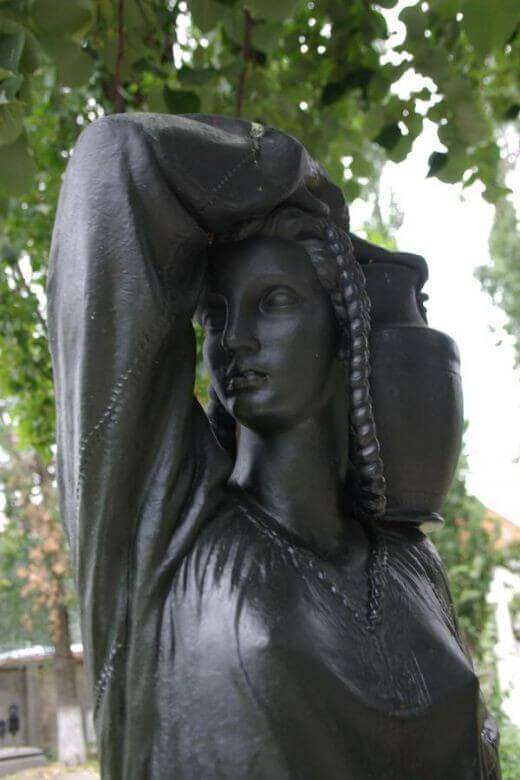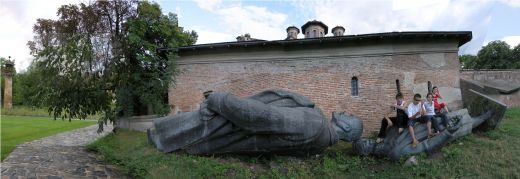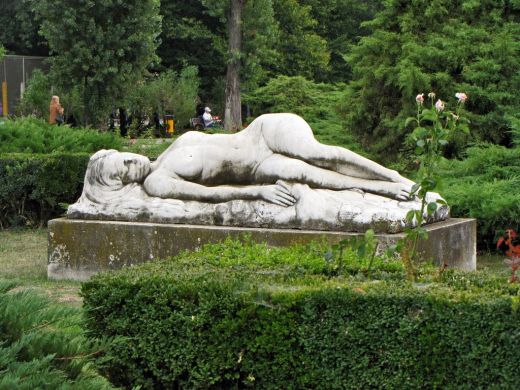- Zombie Paintings at MoMA

- SONGS FEEL LIKE MUSCLE MEMORY, OR, I’M OFF SOCIAL MEDIA, HMU ON YOUTUBE: A Mythography of Domingo Castillo
MĂIASTRA: A History of Romanian Sculpture in Twenty-Four Parts
IGOR GYALAKUTHY

In 1936, Romanian sculptor Constantin Baraschi was commissioned to build a monument for a new park in Bucharest. At the entrance to Herăstrău—then named Parcul Carol II after the then King of Romania—he built the Alley of Caryatids: twenty stone peasant women with jugs of water on their heads, assembled in the Hellenistic style (two rows of ten) that formed a pathway to the centerpiece of his sculptural ensemble: the Modura Fountain. Modura is a heroine of Romanian folklore: a peasant woman said to have given water to a thirsty King Carol II after his plane crash-landed in the Transylvanian woods. Baraschi’s Modura is a full-scale bronze effigy that stands in the center of a small fountain. She is costumed in a traditional Romanian dress and holds a pitcher of water on her left shoulder. Her stolid face gazes west, and a braid of bronze hair falls across her cheek. She is a remarkable work, one whose features capture perfectly the pathos of a nation reconciling its muddled Eastern ancestry with aspirations of Northern European beauty.
After World War II, the Communist regime renamed the park after Joseph Stalin, and a large bronze statue of the dictator was commissioned to replace Baraschi’s monument. The sculptural ensemble was demolished and the statues of Modura and her caryatids were assumed missing or destroyed for a half-century. [Note: the journey of the Stalin bronze, sculpted by the infamously outcast Dumitru Demu and torn down in 1962 in a period of De-Stalinization, is equally fascinating, though subject to rumor. The original has by now almost certainly been melted down.]
One summer day in 2010, while combing through the stalls of Bellu Cemetery in the south of Bucharest, two men made a surprising discovery. Standing peacefully in a shady corner of the graveyard, her stolid face gazing west, a braid of bronze across her cheek, was Modura herself. Sometime during all of the chaos, the old bag wandered off! Sundowning, and feeling of no further use, she fled south, and interred herself in a graveyard ten kilometers away, where she has slept for over fifty years. [Note: recreations of the Modura Fountain and the Alley of Caryatids were made in 2006 by sculptor Ionel Stoicescu in their original positions in Herăstrău Park. The replica is a shade of the original.]
Baraschi’s sculptures have a history of wandering off. In 1959, the artist entered a competition to design a public statue of Communist leader Vladimir Lenin. He lost, and when he lost, as legend goes, he replaced Lenin’s head with that of Romanian playwright Ion Luca Caragiale, the country’s greatest dramatist, who shared Lenin’s girth, if not his politics. The writer, grin- ning under his famous mustache, wears a three-piece suit and a wide-brimmed hat, his left hand placed casually in his pocket as he stands atop a tall stone plinth. He looks everything like a man out for a walk, and between the years 1959 and 2006, that’s exactly who he was. For reasons as bureaucratic as they were political, Caragiale got around. From Baraschi’s studio to a residential courtyard in Splai, to the Cartea Românească Publishing House, to Maria Rosetti Street, to the lawn of the National Theater and back to Rosetti, Caragiale’s journey was nearly seven kilometers and fifty years long. That’s a distance for an old man.
It could have been worse. The winning Lenin, a seven-ton bronze by sculptor Boris Caragea, which stood in front of the Casa Scânteii for thirty years, was torn down by an angry mob in 1990, a year after the Romanian Revolution. For the next twenty years, the Caragea Lenin lay on his stomach, his face in the mud, on the grounds behind Mogoşoaia Palace, an eighteenth-century mansion ten kilometers north of Bucharest. Visitors to the palace snapped photographs of each other walking on the old man’s back, or straddling his bald head like a saddle. [Note: the Lenin bronze has been moved once again, as there are rumblings of a new Communist sculpture park similar to Memento Park in Budapest, though this information is unconfirmed.]
According to legend, there were once two giants, twin brothers, who met a beautiful young nymph and fell deeply in love with her. Unable to choose, the nymph threw herself into the ocean, believing that the twin who rescued her was destined to be her husband. The brothers argued over who would save her, and while they argued, the young girl drowned.
As punishment, the Gods turned the giants to stone, and the nymph to a cascading waterfall. [Note: the origin of this myth is vague, though it bares a strong resemblance to the story of the River Tamar in Southern England, with certain discrepancies.] The Giants are carved Rousse stone, the works of Frederick Stork and Dimitrie Paciurea, two giants of the Romanian school of sculpture in the early twentieth century. The Sleeping Nymph is a marble by Filip Marin, a lesser-known contemporary of Stork and Paciurea’s, possessed of a mastery that always placed him a bit out of the reach of his compatriots. For more than thirty years, Marin’s Sleeping Nymph lay contentedly in her cave, a hand- some stone Giant on either side of her.
The legend has a familiar ending. The park was renamed, the grotto destroyed, and room cleared for a new monument: a mausoleum succinctly titled “Monument of the Heroes for the Freedom of the People and of the Motherland, for Socialism.” Today the Giants remain in Parcul Carol I, now purely ornamental, but Marin’s Sleeping Nymph has stolen away to the safety of Herăstrău, a sort of repository for wayward statuary odds and ends. Once an allegorical celebration of the best of Romanian sculpture, robbed of their context the three lovers are nothing more than awkward replications of antiquity. Meanwhile, the specter of the mausoleum that took their place continues to cast a sinister pallor over the park. [Note: the tomb was repurposed in 1991 to commemorate veterans of World War I. Still ghastly.]
When Baraschi’s Caragiale stood in front of the National Theater, he stood without pedestal, raised off the ground only slightly by a marble curb. With stately Caragiale a man on the street, one was free to imagine each pair of passing hands as those that penned the words “History, for us, must be an endless wellspring of healthy poetry.” In truth, Romanian history is a fetid, smoldering trough. Communism’s greatest threat to the people of this country was the expunging of national memory, and like ancient civilizations, so much of the painting and writ- ing with which we might reassemble our history is gone. Like those ancient civilizations, however, the statuary remains: the sculptures, the busts, the monuments, the tombs. They are the old men and women of Romania, shifting tectonically to odysseys of bronze and stone. The purpose of this column is to locate them once more, and to secure them firmly to the ground.
DR. GYALAKUTHY is a professor emeritus at the Universitatea Nationala de Arte in Bucharest. In 1993, he received the National Medal for achievement in the field of art history. He lives in Cluj-Napoca with his Lakeland terrier Bausa.










